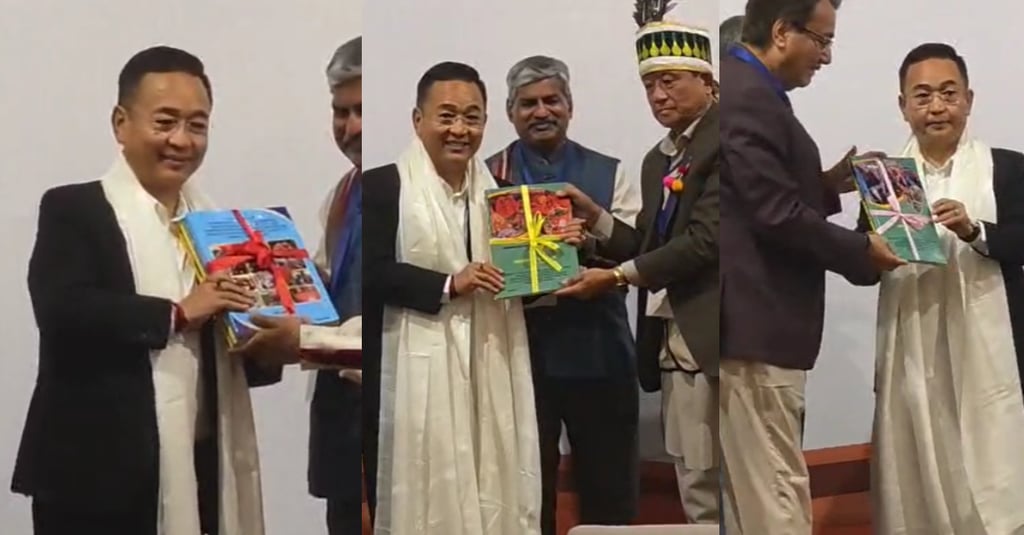Historic step for SIKKIM: Final report on inclusion of 12 left-out communities in ST list submitted
The Delhi meeting was chaired by Chief Minister Prem Singh Tamang and attended by senior officials from the Chief Minister’s Office (CMO), the Social Welfare Department, as well as members of the High-Level Committee.
LOCAL


Sikkim today witnessed a landmark moment as the state moved a step closer to fulfilling one of its oldest and most important aspirations; the recognition of 12 left-out communities as Scheduled Tribes (ST). In a high-level meeting held in the national capital, the Sikkim State High-Level Committee on tribal inclusion formally submitted its much-awaited final report to Chief Minister Prem Singh Tamang (Golay).
The report, prepared after years of detailed study and consultation, recommends the inclusion of 12 communities; Bhujel, Gurung, Jogi, Khas, Kirat Rai, Kirat Dewan Yakha, Majhi, Mangar, Newar, Sanyasi, Sunuwar (Mukhia) and Thami into the ST list under the Constitution of India.
The submission marks the official conclusion of the committee’s work and is widely being described as historic and potentially transformative for the state.
The issue of tribal recognition has remained unresolved for decades, with successive governments, community leaders, and associations pressing for inclusion of these communities in the ST list. Their exclusion has been seen not only as a denial of constitutional justice but also as a roadblock to Sikkim’s broader push to be recognised as a Tribal State.
For years, the demand has echoed across villages, towns, and community platforms in Sikkim. Today’s development is being seen as a major boost to this long fight for recognition and rights.
The Delhi meeting was chaired by Chief Minister Prem Singh Tamang and attended by senior officials from the Chief Minister’s Office (CMO), the Social Welfare Department, as well as members of the High-Level Committee. Representatives and office bearers from the 12 left-out communities were also present, along with special resource persons who contributed their expertise to the preparation of the final document.
During the meeting, the Ethnographic Committee formally handed over its final report, which contains detailed anthropological studies, cultural records, and social documents highlighting the distinct identity and tribal characteristics of the left-out groups.
Chief Minister Tamang described the day’s development as a “historic milestone” and said the report strengthens Sikkim’s long-standing demand to be recognised as a Tribal State. He stressed that the recognition of these communities is not only about constitutional justice but also about safeguarding cultural identity, ensuring socio-economic upliftment, and securing political rights for the people.
Speaking to reporters after the submission, Jacob Khaling, Political Secretary to the Chief Minister, said, “Today’s submission marks the completion of our responsibility at the state level. The committee has compiled all the necessary details. Now it is for the Central Government to act and take the matter forward. The aspirations of the people of these communities, and indeed of Sikkim as a whole, depend on timely recognition.”
Khaling further said that the committee’s report is inclusive and comprehensive, reflecting voices from every section of the communities concerned. He underlined that the next step lies entirely with the Union Government, which will have to examine the report and take legislative action to include the 12 communities in the ST list.
The submission of the report was not only followed closely in New Delhi but also keenly watched across Sikkim. For many, it symbolises the crossing of an important threshold after decades of uncertainty.
Earlier in the day, the start of the high-level meeting itself was described as “historic and decisive” as it carried the potential to reshape the future of the state. Officials noted that the recognition of these 12 communities is directly tied to Sikkim’s larger goal of being formally declared a Tribal State.
With the committee’s task now completed, the Sikkim government will forward the report to the Union Government along with its endorsement. The Centre will then decide the future course of action, which could eventually lead to constitutional and legislative changes.
LOOKING AHEAD
While the submission of the final report is being celebrated, leaders and community members agree that the real test begins now. The demand for ST recognition has been on the table for decades, and expectations are high that the Centre will respond positively and without further delay.
For the 12 communities; many of whom have struggled with questions of recognition, identity, and opportunity today’s development is a step forward filled with hope. The day has rekindled aspirations not only for community rights but also for a more inclusive future for the entire state.
